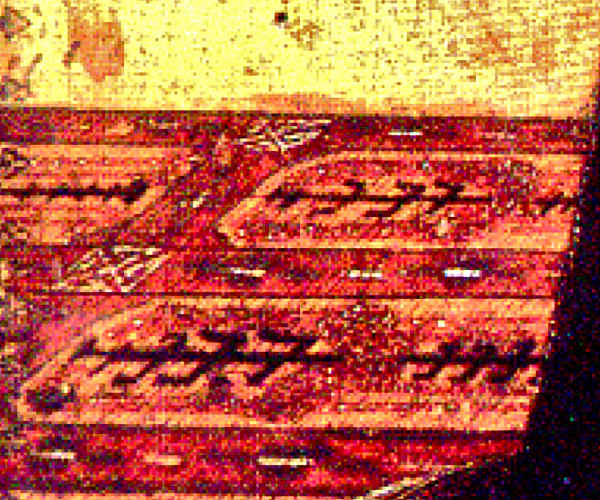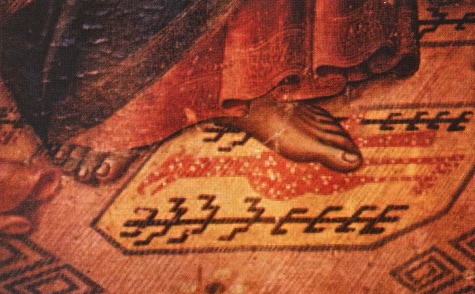Hi all,
In the case of borderless, large rugs, one would often need a much closer view as the one given by the pictures published on the net or in art books, to eliminate the possibility that they are in fact tiles, reeds or textiles.
I managed to select five views close enough to show clearly a very coarse rug structure, (Is this coarseness due to multiple wefts? To thick warps? Structure experts please comment.)
See below detail views of:
FIG 1. T. Gaddi’s «Calling of St Eloi», 1360, Prado, Madrid. (shown in the essay).
Its pendant «St Eloi before King Clothaire» does also show rows of pile with the same orientation.
 FIG 2.
FIG 2. N. Buonaccorso’s «Marriage of the Virgin», 1380. National Gallery. London. (shown in the essay)
 FIG 3.
FIG 3. Sassetta’s «Virgin and Child», ca. 1433, Vatican.
 FIG 4.
FIG 4. Sano di Pietro’s «Virgin and Child», ca.1455, Duomo di Pienza.
The same rug is also featured in di Pietro’s «Coronation of the Virgin», ca.1455, Yale University.
The bird might be an eagle. Note the chintamani-like spots.
 FIG 5.
FIG 5. Sano di Pietro’s adoration of the Child, 1460-1470, Kress Collection.
Raptor, with long neck and asian swastika motif.

There is now little doubt left in my mind that most of these paintings with highly stylized, filiform or well-fed, animals inscribed in an octagon or rectangle, indeed feature (borderless) coarse rugs. A few paintings might show tiles with similar motifs.
OK, let’s assume that the painters indeed intended to show rugs, but were they fully invented? Or did the painter use true models? In the second case who wove them? These are questions we can’t answer.
I do share Filiberto’s, Yohann’s and Marvin’s opinion that they are perhaps the fruit of both European and Middle East influences. Whether they were made in Italy, El Andalus, Cilician Armenia, Byzantine Greece or Anatolia, Trebizond or other exotic places can only be a wild guess as long as no extant fragment will be found.
Best regards
Pierre